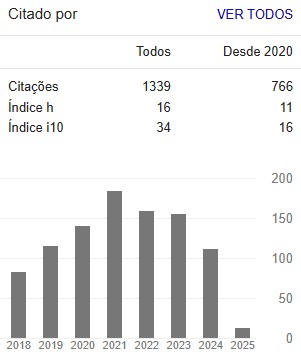MASTECTOMIA BILATERAL COM USO DE PICO™ SOFTPORT – SISTEMA DE TERAPIA DE PRESSÃO NEGATIVA DE FERIDAS
Palavras-chave:
Câncer de Mama, Neoplasia Mamária, Mastectomia, PICO™ SoftportResumo
Atualmente, a principal forma de neoplasia maligna entre as mulheres é o câncer de mama. Com o advento da radioterapia, a cirurgia conservadora da mama (quadrantectomia) tornou-se uma técnica possível. Todavia, a mastectomia radical ainda mantém suas indicações frente a uma patologia mais avançada ou em pacientes portadoras de mutações deletérias dos BRCA 1/BRCA 2. Infelizmente, as complicações da ferida operatória existem. Frente a este problema, o PICO™ Softpor – Sistema de terapia de pressão negativa de feridas, é um dispositivo único que vem sendo usado no sistema de terapia de feridas com pressão negativa para melhorar a cicatrização de feridas, isso inclui a perfusão aprimorada, a remoção de excesso de líquido e edema levando a menor tensão na ferida operatória. O estudo objetivou relatar a experiência do uso do Sistema de Terapia de Pressão Negativa de Feridas através do PICO™ Softport no tratamento cirúrgico de câncer de mama através de um relato de caso. Paciente M. R. V., sexo feminino, 57 anos, G2P2A0, assintomática com diagnóstico de T4BN0M0 em mama direita e T1N0M0 em mama esquerda foi submetida à mastectomia radical modificada bilateral. Utilizamos curativo bilateral com o Sistema de Terapia de Pressão Negativa de Feridas na forma de PICO™ Softport, o que possibilitou a redução nas complicações de cicatrização da incisão. Após a recuperação cirúrgica, paciente passou por radioterapia adjuvante, apresentando-se até o momento deste relato estável em uso de anastrozol, encontrando-se totalmente satisfeita com o resultado cicatricial dérmico que o dispositivo proporcionou.
Downloads
Referências
BULLOUGH, L.; WILKINSON, D.; BURNS, S.; WAN, Y. L. Changing wound care protocols to reduce postoperative caesarean section infection and readmission. Wounds UK; Vol 10; No 1; 2014.
DIETZ, J.; LUNDGREN, P.; VEERAMANI, A.; O´ROURKE, C.; BERNARD S.; DJOHAN, R.; LARSON, J.; ISAKOV, R.; YETMAN, R. Autologous inferior dermal sling (autoderm) with concomitante skin-envelope reduction mastectomy: na excelente surgical choice for women with macromastia and clinically significant ptosis. Ann Surg Oncol 2012 Oct; 19(10): 3282-8.
FISHER, B. Biological research in the evolution of cancer surgery: a personal perspective. Cancer Res. 2008;68(24):10007-20.
GALIANO, R.; DJOHAN, R.; SHIN, J.; HUDSON, D.; HULST, V.; BEUGELS, J.; DUTEILLE, F.; HUDDLESTON, E.; COCKWILL, J.; MEGGINSON, S. The effects of a single use canister-free Negative Pressure Wound Therapy (NPWT) System on the prevention of postsurgical wound complications in patients undergoing bilateral breast reduction surgery. Trademark of Smith & Nephew, 2014, 53625.
GOMOLL, A. H.; LIN, A.; HARRIS, M. B. Incisional vacuum-assisted closure therapy. J Orthop Trauma. 2006 Nov-Dec;20(10):705-9.
HOLT, R.; MURPHY, J. PICO™ incision closure in oncoplastic breast surgery: a case series. British Journal of Hospital Medicine Vol. 76, No. 4. 2015.
ISLAM, A.; AZIZ, I.; SHAH, J.; OBA, J.; HARNARAYAN, P.; RAMPERSAD, A. J.; NARAYNSINGH, V. The Impact of Breast Clinic on the Mastectomy and Axillary Clearance Rates at a Tertiary Hospital in an Eastern Caribbean Nation: A Comparative Study. Int J Breast Cancer. 2019; 2019: 8018242.
MAGANN, E. F.; CHAUHAN, S. P.; RODTS-PALENIK, S.; BUFKIN, L.; MARTIN, J. N. J.; MORRISON, J. C.; Subcutaneous stitch closure versus subcutaneous drain to prevent wound disruption after cesarean delivery: a randomized clinical trial. Am J Obstet Gynecol 2002;186:1119–23.
REZENDE, L. F.; BELETTI, P. O.; FRANCO, R. L.; MORAES, S. S.; GURGEL, M. S. C. Exercícios livres versus direcionados nas complicações pós-operatórias de câncer de mama. Rev. Assoc. Med. Bras. vol.52 no.1 São Paulo Jan./Feb. 2006.
SPILIOTIS, J.; TSIVERIOTIS, K.; DATSIS, A. D.; VAXEVANIDOU, A.; ZACHARIS, G.; GIAFIS, K.; KEKELOS, S.; ROGDAKIS, A. Wound dehiscence: is still a problem in the 21st century: a retrospective study. World J Emerg Surg 2009;4:12.
STANNARD, J. P.; GABRIEL, A.; LEHNER, B. Use of negative pressure wound therapy over clean, closed surgical incisions. Int Wound J 2012; 9 (Suppl. 1):32–39.
STANNARD, J. P.; VOLGAS, D. A.; McGWIN, G. III.; STEWART, R. L.; OBREMSKEY W.; MOORE, T.; ANGLEN, J. O.; Incisional negative pressure wound therapy after highrisk lower extremity fractures. J Orthop Trauma 2012;2637–42.
URBAN, C.; FREITAS-JUNIOR, R.; ZUCCA-MATTHES, G.; BIAZÚS, J. V.; BRENELLI, F. P.; PIRES, D. M.; SILVA, A. V.; RESENDE, M. A.; PAULINELLI, R. R.; LUCENA, C. E. M.; BARBOSA, E.; RUIZ, C. A.; PRUDÊNCIO, R. M. A.; OLIVEIRA, V. M.; VILLAVERDE, R. Cirurgia oncoplástica e reconstrutiva da mama: Reunião de Consenso da Sociedade Brasileira de Mastologia. Rev Bras Mastologia. 2015; 25(4):118-24.
ZUCCA-MATTHES, G.; MANCONI, A.; VIEIRA, R. A. C.; MICHELLI, R. A. D.; MATTHES, A. C. S. The evolution of mastectomies in the oncoplastic breast surgery era. Gland Surg. 2013;2(2):102-6.
ZUCCA-MATTHES, G.; VIEIRA, R. A. The value of patients’ expectation on breast oncoplastic surgery. Breast J. 2014;20(6):676-8.
Downloads
Publicado
Edição
Seção
Licença
Os artigos submetidos à revista Colloquium Vitae estão licenciados conforme CC BY-NC-ND. Para mais informações sobre essa forma de Licenciamento, consulte: http://creativecommons.org/licenses/by-nc-nd/4.0/.
A disponibilização é gratuita na Internet, para que os usuários possam ler, fazer download, copiar, distribuir, imprimir, pesquisar ou referenciar o texto integral dos documentos, processá-los para indexação, utilizá-los como dados de entrada de programas para softwares, ou usá-los para qualquer outro propósito legal, sem barreira financeira, legal ou técnica.

